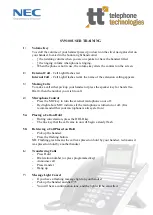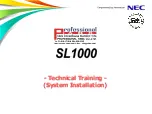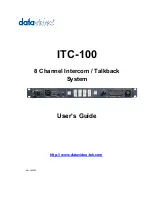
Page 2
Copyright © 2005 - ASR Electronics. All rights reserved.
The writer assumes no responsibility whatsoever for any damage of any kind suffered as a result of
attempting this modification. Also be aware that any sub-assembly that has been modified will no
longer be covered by the manufacturers warranty. If this modification is done without taking the
proper care, any resultant damage – either immediate or future – is the responsibility of the
individual who performed the work.
Prior to commencing the modification, obviously the head unit itself needs to be removed from the car. This
is most easily achieved by using either the “special tool” purchased from Blaupunkt themselves (around
$20-25) or by using some stout wire bent as shown in the photo seen a couple of pages on, a total cost
of…. Well, how much is a coat hanger?
Avoid using the thinner (~2mm) coat hanger wire – use one of the PVC covered coat hangers (about 3mm
thick wire), and strip the PVC covering off .
In addition to the head unit though, the cradle also needs to be removed. This does entail removal of a few
trim panels, but isn’t that difficult once the location of Holden’s “hidden screws” is revealed.
What you’ll need:
There are a few essential tools to get the job done, and a couple more that are nice to have if you do. A
roundup of the hand tools you’ll need…
Screwdrivers – a couple of #2 Phillips head drivers including a “stubby”, a couple of flat blade drivers are
also handy. A set of jewellers screwdrivers are important also.
Torx drivers – a set of miniature Torx drivers are essential, specific sizes you’ll need are T-8, T-9, and T-10.
Wire cutters/nippers – you’ll need a decent quality pair of miniature sidecutters, in good condition.
Needle files – Whilst not absolutely essential, these are very useful for cleaning up the cradle metalwork
following the cutting of the slot. A larger file can be used, provided adequate care is taken. (an ice cream
stick with emery paper is a good substitute)
A “Dremel” style rotary tool – It doesn’t have to be a genuine Dremel (mine isn’t!), but a similar style tool
with a thin metal cutting disc attached.
Power drill – A cordless is fine, and you’ll need some drill bits. Specifically, 2.5mm and 5mm. The bits need
to be in good condition, and sharp. Incidentally, if you have a drill press this is even better. A 1mm bit with a
“pin vise” makes registration of the external cable assembly much more accurate also – explanation further
in the text.
Soldering iron or station – I’m not talking about the one you do the plumbing with, you’ll need a good quality
iron which is designed for electronics work. It’ll need to be fitted with a very fine tip, as some of the soldering
points are quite small and the heat doesn’t transfer well from a larger tip. Additionally there is a severe risk
of damage to the main PCB in the head unit if an inappropriate soldering tool is used.
Hot-melt glue gun – the miniature ones are the best (the glue sticks are only around 6-7mm diameter) but a
standard sized one will work as well.
Epoxy adhesive – the slow set type is recommended, although the 30 minute variety should be adequately
strong. The reason for this recommendation is that the slower setting epoxies generally form a stronger
bond than the 5 / 10 / 30 minute varieties, but six hours can be a little long to wait in certain circumstances.
The cure time can be shortened somewhat by gently warming the joint during cure (say with a fan heater
set to low heat positioned a couple of feet away) but bear in mind that by introducing heat you’re probably
sacrificing some of the strength.
Scrap wooden block – whilst drilling the cradle metalwork it is important to support it to avoid bending and
potential misalignment later on. The block needs to be long enough to reach from the back of the cradle to



































